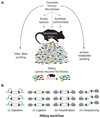Our unindicted coconspirators: human metabolism from a microbial perspective
- PMID: 20674856
- PMCID: PMC2935662
- DOI: 10.1016/j.cmet.2010.07.001
Our unindicted coconspirators: human metabolism from a microbial perspective
Abstract
The human gut is populated by a microbiota composed of tens of trillions of organisms and millions of genes that together form a metabolic "organ." Intra- and interpersonal differences in the structure and functions of this organ suggest that it could contribute to our normal metabolic variations and also to metabolic disorders. This Commentary discusses experimental approaches for connecting microbial and host metabolism in the context of health and disease.
Copyright 2010 Elsevier Inc. All rights reserved.
Figures

References
MeSH terms
Grants and funding
LinkOut - more resources
Full Text Sources
Other Literature Sources

